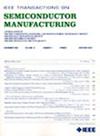Deep Clustering and Regression Ensemble Network for Lot Cycle Time Prediction in Semiconductor Wafer Fabrication
IF 2.3
3区 工程技术
Q2 ENGINEERING, ELECTRICAL & ELECTRONIC
引用次数: 0
Abstract
Accurate cycle time (CT) prediction is crucial in semiconductor manufacturing. Hybrid models integrating classification and prediction models can enhance CT prediction accuracy. However, existing methods have limitations, including challenges in capturing the dynamic conditions of the production line and optimizing job classification to ensure high CT prediction performance. In this study, we propose a novel hybrid framework for predicting process step-level CT in semiconductor wafer fabrication, thereby addressing the limitations of previous methods. Moreover, the paper formalizes and introduces dynamically changing manufacturing environment attributes as variables that contribute to CT. The proposed method combines deep embedded clustering (DEC) with a regression ensemble network. First, the DEC extracts cluster-friendly representative features from high-dimensional CT datasets and classifies jobs accordingly. Then, a weighted ensemble approach merges regression networks based on cluster membership probabilities. Unlike existing methods that separately handle feature extraction, job classification, and CT prediction, the proposed unified network synchronizes these processes. Experimental results using real-world operational data from a semiconductor manufacturing system indicate that the proposed prediction method considerably outperforms previous approaches in terms of prediction accuracy. To the best of our knowledge, this is the first study to integrate deep clustering with a regression ensemble network for predicting cycle time at the process step level in semiconductor manufacturing. By synchronizing feature extraction, clustering, and prediction tasks, the proposed framework achieves enhanced accuracy and robustness in dynamically changing manufacturing environments.半导体晶圆制造中批量周期预测的深度聚类与回归集成网络
精确的周期时间(CT)预测在半导体制造中至关重要。结合分类模型和预测模型的混合模型可以提高CT的预测精度。然而,现有方法存在局限性,包括在捕获生产线动态条件和优化作业分类以确保高CT预测性能方面存在挑战。在这项研究中,我们提出了一个新的混合框架来预测半导体晶圆制造过程中的阶跃级CT,从而解决了以前方法的局限性。此外,本文还形式化并引入了动态变化的制造环境属性作为有助于CT的变量。该方法将深度嵌入聚类(DEC)与回归集成网络相结合。首先,DEC从高维CT数据集中提取聚类友好的代表性特征,并相应地对作业进行分类。然后,基于聚类隶属概率的加权集成方法合并回归网络。与现有的分别处理特征提取、作业分类和CT预测的方法不同,本文提出的统一网络将这些过程同步化。使用来自半导体制造系统的实际操作数据的实验结果表明,所提出的预测方法在预测精度方面大大优于先前的方法。据我们所知,这是第一个将深度聚类与回归集成网络相结合的研究,用于预测半导体制造过程步骤水平的周期时间。通过同步特征提取、聚类和预测任务,该框架在动态变化的制造环境中实现了更高的精度和鲁棒性。
本文章由计算机程序翻译,如有差异,请以英文原文为准。
求助全文
约1分钟内获得全文
求助全文
来源期刊

IEEE Transactions on Semiconductor Manufacturing
工程技术-工程:电子与电气
CiteScore
5.20
自引率
11.10%
发文量
101
审稿时长
3.3 months
期刊介绍:
The IEEE Transactions on Semiconductor Manufacturing addresses the challenging problems of manufacturing complex microelectronic components, especially very large scale integrated circuits (VLSI). Manufacturing these products requires precision micropatterning, precise control of materials properties, ultraclean work environments, and complex interactions of chemical, physical, electrical and mechanical processes.
 求助内容:
求助内容: 应助结果提醒方式:
应助结果提醒方式:


